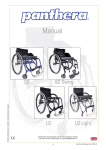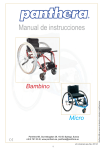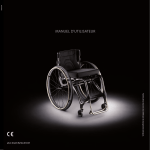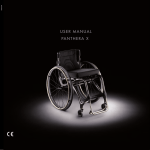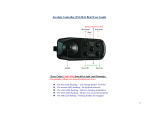Download User Manual - Wheels2move
Transcript
User Manual Panthera AB reserves the right to make technical changes. Bambino Micro Panthera AB, Gunnebogatan 26, SE-163 53 Spånga, Sweden +46 8-761 50 40, www.panthera.se, [email protected] art.nr.bruks-barn-eng Rev. 2011-01 1 CONTENTS DESCRIPTION Introduction 2 Contact 2 Description 3 Safety instructions 3-5 Overview 6 Settings 7-13 Accessories 13 Transport 14 Crash testing 15 Maintenance 16 Warranty 16 Technical facts 17-18 Panthera Bambino We at Panthera manufacture active chairs that have been continuously acknowledged over the years as the most free-rolling and easiest to manoeuvre chairs on the market. Panthera Bambino is no exception. It is an everyday chair for children with excellent rolling properties and it has the same superb qualities as its larger family members. Thanks to our broad accessory line and the many adjustment options, a very large group of different children can use Bambino. It is easy to manoeuvre, easy to adjust and easy to lift. Panthera Bambino is simply a truly active chair for children from about 4 to 12 years of age. Panthera Micro Panthera Micro is the chair for the youngest children. As we all know, being able to move about independently is very important, and not the least for a child. Panthera Micro is therefore built to be as easy to manoeuvre as possible. Chrome molybdenum and titan form the frame; the front wheel for marathon chairs is the drive wheel. Just as with many tennis chairs, it has just one front wheel for easier rotation. Panthera Micro is made for children between 1 and 5 years of age and intended for indoor use. INTRODUCTION We congratulate you on your choice of a wheelchair from Panthera AB and we hope you will be satisfied with this product. All products from Panthera AB are designed and assembled in Spånga, outside of Stockholm. They are built to be market leading when it comes to quality, ease of manoeuvrability and low weight. SAFETY INSTRUCTIONS Make sure you have received the chair you ordered: - Check the chair width. - Check the backrest height. - Check that you have received the accessories you ordered. Intended use CONTACT If you have any questions or need help with your product, first contact your local supplier (assistance centre). To contact the manufacturer, see the information below: Panthera AB Gunnebovägen 26 SE-163 53 Spånga, Sweden +46 8-761 50 40, www.panthera.se, [email protected] Panthera AB reserves the right to make technical changes. We strongly recommend that you carefully read the entire user manual. Conduct a technical inspection of the chair. Check that: Panthera AB reserves the right to make technical changes. Panthera Bambino and Micro are wheelchairs built for children who need an easily manoeuvred, everyday wheelchair that permits them to sit comfortably and ergonomically. The chassis has narrow outer dimensions and is the lightest currently available on the market. For optimal use of the Panthera wheelchair, you or a qualified professional must make the necessary adjustments so that the child sits comfortably, and so that the chair is easy to manoeuvre and is properly balanced. It is therefore important that you read the instructions for making adjustments to your Panthera. - The drive wheels move smoothly in and out of their nut pieces. - The drive wheels are properly secured after assembly. - The button for the quick release lock in the hub springs out entirely. - All wheels are in contact with the floor. - The fork for the caster is easy to turn. - The backrest is easy to fold down. Only Bambino. Balance and tip sensitivity The placement of the drive wheels, the backrest angle and the backrest upholstery's adjustment have the greatest effect on the wheelchair's sensitivity to tipping. After adjustment of the chair, check that the chair's balance feels right. Tip sensitivity is also influenced by whether a bag is hanging on the backrest, the child is leaning/reaching back, the tyres are worn, the tyres are poorly inflated or whether an unanticipated change to the surface is encountered. art.nr.bruks-barn-eng Rev. 2011-01 2 art.nr.bruks-barn-eng Rev. 2011-01 3 SAFETY INSTRUCTIONS SAFETY INSTRUCTIONS WARNING: Micro A Panthera chair is designed to be as easily manoeuvred as possible. Because the chair is so easily manoeuvred, it reacts quickly and easily to the user's actions. If the user performs the wrong action it can tip backwards for example, if no anti-tip devices are fitted. It is fully possible to tip the chair. The anti-tip devices are safety components designed to prevent the chair from tipping backwards and are not intended for constant operation. If the user manoeuvres the chair in such a manner that the anti-tip devices are frequently used, they must be checked daily. If the wheelchair is equipped with electrically powered drive wheels, the load on the anti-tip devices can significantly increase and they should then be checked daily. Intended for indoor use The reason for the chair only being suitable for indoor use is that it has just one front wheel (to make it easier to turn). This entails a risk for the chair tipping forwards at an angle if it is moving rapidly and encounters an obstacle or dip. This can also happen indoors but is much less common. Most small children need a belt to prevent them from losing balance and falling out of the chair. A basic belt is supplied with the chair. If this is not sufficient, the child must not use the chair until the prescriber has obtained one that provides satisfactory protection. It is important that the child has been able to properly try out the chair and takes the time to practice his or her wheelchair technique. If you have any questions concerning wheelchair technique, contact your prescriber/therapist. Please feel free to contact us at Panthera AB as well. Bambino Brakes Bambino If using our high brakes, care must be taken to not catch the fingers when operating with the drive wheels. If the high brakes are used and the child will be moving laterally to or from the chair, it is important that he or she clears the braking mechanism so as to avoid fastening in it. Keep in mind that the brakes are less effective when the tyres are poorly inflated or worn. Because tyre sizes can vary, always check the brakes after changing the tyre type. The brakes are designed as parking brakes and not as service brakes. NB: For the brakes to function, the tyres must be correctly inflated. See the technical information. Moving/lifting (Figure 1) Due to the chair's low weight, it can shift laterally when the child moves to the chair from the side and the brakes are applied. If you are uncertain, have the child practice this move with your prescriber. If the wheelchair is to be lifted along with the child, always grip the wheelchair's frame – not the backrest, push bar, leg support, wheels or other moving parts. See Figure 1 Seat adjustment Because spoke guards make the chair more difficult to manoeuvre, they are not standard. But if the child is with other children, there is a risk of fingers or hands being caught between the spokes, and spoke guards can thus be necessary. Manoeuvring Bambino If the distance between the foot plate's lowest part and the underlying surface is less than 40 mm, the foot plate can catch on surface projections and cause falls forwards. If the child is being pushed or moving independently down over a kerb with the anti-tip devices extended, they can catch on the kerb edge and cause a fall forwards. If you are uncertain, retract the anti-tip devices and ask for help. Panthera AB reserves the right to make technical changes. Other children can hurt themselves on the wheels. Panthera AB reserves the right to make technical changes. Incorrect seat adjustment can cause pressure sores. If uncertain, immediately contact your prescriber. Ensure that the side guards do not press too hard against the thighs as this can cause pressure sores. If the side guards are applying too much pressure, the chair is either too narrow or the side guards require adjustment. The seat is intended for use with a cushion. Figure 1 art.nr.bruks-barn-eng Rev. 2011-01 4 art.nr.bruks-barn-eng Rev. 2011-01 5 OVERVIEW - Bambino (Figure 2) ADJUSTMENTS When adjusting the seat to the child's posture and balancing the chair (necessary for attaining the desired manoeuvring properties), it is important that you do this in the correct order. You must adjust the seat before adjusting the balance. This is because the chair's balance shifts when you adjust the seat. Keep in mind that the little extra time spent on correctly adjusting the chair will be well worth the effort. Try different settings over the course of a day to ensure that you have correctly adjusted the seat and balanced the chair. Make the adjustments in the following order: 1. Backrest 2. Drive wheel 3. Seat/cushion 4. Chassis 5. Foot plate 6. Caster 7. Front fork 8. Push rim 9. Anti-tip device 10. Rear axle 11. Quick release hub 12. Air valve 13. Backrest release 14. Brakes 1) Seat upholstery 2) Foot plate 3) Backrest and upholstery 4) Wheelchair balancing 5) Positioning of brakes Bambino 6) Anti-tip device Bambino Figure 2 OVERVIEW - Micro (Figure 3) 1. Backrest 2. Drive wheel - tyre 3. Seat/cushion 4. Chassis 5. Foot plate 6. Front fork 7. Caster 8. Rear axle 9. Anti-tip device 10. Quick release hub 11. Air valve 1) Seat upholstery depth (Figures 4 and 5) Figure 3 Panthera AB reserves the right to make technical changes. Panthera AB reserves the right to make technical changes. By moving the seat extension forwards and backwards, you can adjust the seat depth. Loosen the front part of the seat by pulling backwards (the seat is secured with a Velcro fastener). Adjust the seat depth and secure with the Velcro fastener. Bambino Micro Figure 4 Figure 5 art.nr.bruks-barn-eng Rev. 2011-01 6 art.nr.bruks-barn-eng Rev. 2011-01 7 ADJUSTMENTS ADJUSTMENTS 1) Seat upholstery tension Micro Bambino (Figures 6 and 7) 3) Backrest Bambino (Figures 10, 11 and 12) The tension of the rear half of the seat upholstery can be adjusted by tightening or releasing the Velcro strap at the bottom of the seat; Figures 5 and 6. This enables you to vary the seat height by about 2 cm, upwards or downwards. Backrest height (Figure 10) First loosen the bolts on both sides; see Figure 9. Next release the backrest upholstery from the tensioning straps. You can now adjust the backrest to a suitable height by moving the backrest columns upwards or downwards. Once you have found a suitable height, retighten the bolts. Remove the unattached strap if the backrest is adjusted to a low position. 2) Foot plate Micro (Figure 8) Vertically: You can adjust the foot plate upwards or downwards by changing holes on the bracket. Remove the screws that secure the foot plate. You can now move the foot plate upwards or downwards to one of the vertical positions. The foot plate must be at a height that provides support for the undersides of the thighs against the seat at the same time as the feet are supported by the foot plate. Horizontally: The foot plate can be turned so that the plate is backwards or forwards. Remove the two screws that secure the foot plate. Turn the plate and retighten the screws. Backrest angle (Figures 11 and 12) 1) Release the backrest locking function by pulling the cable (4) – see Figure 10 – and folding the backrest forwards. 2) Loosen the lock nuts (2) with a 13-mm spanner, and screw in the adjustment screws (3) using a 5-mm Allen key. 3) Loosen the bolts (5) and (6) – see Figure 11 – with a 10-mm spanner. 4) Fold back the backrest so that the locking pin (7) springs out. 5) Adjust the desired angle by moving the entire backrest forwards or backwards. 6) Tighten the bolts (5) and (6) with a 10-mm spanner. 7) Use the adjustment screws (3) to eliminate play using a 5-mm Allen key so that both of the adjustment screws are even with the frame. Tighten the lock nuts (2) with a 13-mm spanner. 8) Check that the locking pins spring out in their locking slots when the backrest is folded back. Foot plate Bambino (Figure 9) Figure 9 Figure 8 Panthera AB reserves the right to make technical changes. Figure 7 Figure 6 Panthera AB reserves the right to make technical changes. Vertically: Loosen the screws (1) – see Figure 8 – and adjust the plate upwards or downwards. Tighten the screws again. If the feet need to be further down, you can turn the bracket for the foot plate so that it is straight down. Horizontally: Loosen the screws (2) and fully open the hinge clamp, and then carefully lift the foot plate forwards or backwards. Angle: Before you tighten the screws (2), set the desired angle. Fully tighten the screws. Figure 10 Figure 11 Figure 12 art.nr.bruks-barn-eng Rev. 2011-01 8 art.nr.bruks-barn-eng Rev. 2011-01 9 ADJUSTMENTS ADJUSTMENTS 3) Backrest Bambino (Figures 13) 4) Wheelchair balancing Backrest upholstery tension: This is adjusted by tightening or loosening the straps with Velcro fasteners at the rear of the backrest. The backrest upholstery also has a tab that fastens under the seat upholstery with a Velcro strap. You can move this forwards or backwards to attain suitable tension for the backrest upholstery's lower section (called the seat bucket). By changing these adjustments, you can form the backrest upholstery to the shape of the child's back so that there is suitable support for the lower back. Begin by releasing the strap and then seat the child as far back as possible in the chair. Tension the strap so that good support is attained. If it seems that the child is not sufficiently far back in the chair, this can be because the backrest upholstery's lower tab is attached too far forward under the cushion upholstery. Release it and move it backwards. Bambino (Figure 15) Adjust the balance of the wheelchair by moving the drive wheels (rear axle) forwards or backwards. The further forward you position the drive wheels, the more the chair will be balanced to the rear. This causes the chair to be light at the front and there will be more weight over the drive wheels. The chair will be easier to manoeuvre and also easier to lift by the back wheels when passing over curbs, thresholds, etc. However, the chair must not be overly balanced to the rear because there is then the risk of it tipping backwards. It is important that you take the time to properly test until you have found a balance that suits the child's body and manoeuvring technique so that the chair is as easy to manoeuvre as possible without excessive risk for tipping. After making adjustments to the chair balance, someone should always be behind the chair when testing. If you are still uncertain of whether the chair is correctly balanced after thorough testing, you should use our anti-tip device. The anti-tip device makes it impossible to tip backwards and is easy to remove when it is no longer needed. Backrest Micro (Figure 14) Move the drive wheels as shown; see Figure 15: Backrest upholstery tension The backrest upholstery can be tensioned or released by tensioning or releasing the Velcro straps at the rear of the backrest; see Figure 14. The backrest upholstery has a tab that fastens under the seat upholstery with a Velcro strap. You can move this forwards or backwards to attain suitable tension on the backrest upholstery's lower section (called the seat bucket). By making these adjustments, you can form the backrest upholstery to the shape of the child's back so that there is suitable support for the lower back. Begin by releasing the strap and then seat the child as far back as possible in the chair. Tension the strap so that good support is attained. If it seems that the child is not sufficiently far back in the chair, this can be because the backrest upholstery's lower tab is attached too far forward under the cushion upholstery. Release it and move it backwards. 2. Loosen the nuts (1) with a 15-mm spanner on both sides of the chair. 3. The rear axle can now be moved forwards and backwards along the longitudinal frame tube. It is important that the wheel brackets are the same distance forwards on both sides. This is easiest to check by measuring the distance as shown in Figure 14 with a measuring tape or ruler, and checking that the distance is the same on both sides. Panthera AB reserves the right to make technical changes. 4. Now tighten the nuts (1) so that the rear axle is securely attached. Panthera AB reserves the right to make technical changes. Figure 14 Figure 13 1. First remove the drive wheels. Figure 15 art.nr.bruks-barn-eng Rev. 2011-01 10 art.nr.bruks-barn-eng Rev. 2011-01 11 ADJUSTMENTS ADJUSTMENTS 4) Wheelchair balancing 4) Positioning of the brakes Bambino (Figure 17) Micro (Figure 16) The brakes must be adjusted so that in the locked position, they press about 3-4 mm into the tyres. Adjust by loosening the brake clamping bolt with a 10-mm spanner and a 4-mm Allen key, after which you can move the brakes forwards or backwards along the frame's seat tubes. Try different positions until the brakes are correctly adjusted and then retighten the clamping bolt. NB: The braking force will change if the air pressure is too low, the tyres worn or when changing to another tyre type. You should therefore regularly check the position of the brakes. Adjust the balance of the wheelchair by moving the drive wheels (rear axle) forwards or backwards; see Figure 16. The further forward you position the drive wheels, the more the chair will be balanced to the rear. This causes the chair to be light to the front and there will be more weight over the drive wheels. The chair will be easier to manoeuvre and also be easier to lift by the back wheels when passing over thresholds, etc. The chair must not however, be excessively balanced to the rear as this can create a feeling of insecurity. It is therefore important that you take the time to properly test until you have found a balance that suits the child's body and manoeuvring technique, so that it is as easy to manoeuvre as possible. 4) Anti-tip device Bambino (Figure 18) With the anti-tip device lowered, adjust the ground clearance by placing the wheel tube in one of the four positions shown in Figure 18. The anti-tip device can be folded away under the frame when not needed. Do this be pressing down the anti-tip device and then turning it under the seat. When you later fold out the anti-tip device, make sure that it is secured in the locking slots. When the child is learning back wheel manoeuvring, the anti-tip device should be set at a height that permits the chair to be balanced. To move the drive wheels: 1. First remove the drive wheels. 2. Loosen the bolts at the bottom of the rear axle bracket on both sides of the chair; see Figure 16. 3. The wheel bracket can now be moved forwards and backwards along the longitudinal frame tube. It is important that the wheel brackets are the same distance forwards on both sides. This is easiest to check by measuring the distance between the horizontal frame tube's front edge and the wheel bracket's rear edge with a measuring tape or ruler, and checking that the distance is the same on both sides; see Figure 16. 4. Now tighten the bolts so that the rear axle is securely attached. Figure 16 Panthera AB reserves the right to make technical changes. Panthera AB reserves the right to make technical changes. Keep in mind that the little extra time spent on correctly adjusting the chair will be well worth the effort. Try different settings over the course of a day to ensure that you have correctly adjusted the seat and balanced the chair. After about one month, make a new check to see that everything is functioning as it should. Figure 18 Figure 17 art.nr.bruks-barn-eng Rev. 2011-01 12 art.nr.bruks-barn-eng Rev. 2011-01 13 TRANSPORTATION CRASH TESTING Securing the wheelchair in a vehicle Bambino (Figure 19 and 20) Crash-tested and approved Bambino The wheelchair must always be turned to the vehicle’s direction of travel when the user is sitting in the chair while underway. The wheelchair must always be secured in the vehicle with a 4-point safety belt system. The belts are tensioned at the front edge around the tubes at the bearing sleeves for the link wheels. See Figure 19. At the rear, the belts are secured around the rear axle. NB: Do not use metal hooks directly against the rear axle. See Figure 20. Pull the wheelchair backwards and pull hard on the rear belts so that the wheelchair is stationary and moves neither forwards nor backwards. Once the chair is properly secured, set the brakes if the chair is equipped with brakes. We also recommend folding out the anti-tip device if the chair is so equipped. Make sure that all belts and buckles are properly tensioned in the rail on the floor and that all are pulled tight. Panthera's Bambino wheelchair has been approved for use during transport in vehicles operated by services for transport of the disabled as follows. We provide instructions for how the chair is to be secured in an approved manner and which materials have been used during testing. The following wheelchair models and materials were used upon approval according to the tests below. This documentation is based on the results obtained when Panthera's wheelchairs were crash-tested according to ISO-7176-19:2001 and ISO-10542:2000. The crash test was conducted by: SP Technical Research Institute of Sweden Test dates: 20 February 2003 and 12 November 2008. Panthera Bambino: Attachment equipment: Unwin belt, 4-point with snap hook User seat belt: Unwin 3-point seat belt, high deflector Fastening: Unwin low profile rail Test dummy: Hybrid III dummy (weight 50 kg) During this crash test we collaborated with Unwin, which manufactures attachment equipment for wheelchairs. For more information about the belts, please contact Unwin. Figure 20 Figure 19 Securing the user Bambino (Figures 21 and 22) Wheelchair configuration during crash testing Figure 22 Panthera AB reserves the right to make technical changes. Figure 21 The wheel chair that we have crash-tested had the following configuration during testing: Panthera AB reserves the right to make technical changes. If the child will remain in the wheelchair while travelling, we recommend that the wheelchair's backrest be even with or above the child’s shoulder blades. The child must be restrained in the vehicle with a 3-point safety belt. This is to minimise the risk of injury to the head and/or rib cage in the event of a collision or hard braking. The vehicle's safety belt must be against the body and may not be held away from the body by any part of the wheelchair. See Figures 21 and 22. Any unattached wheelchair parts must be removed to reduce the risk of injury to the child or other passengers. Panthera Bambino: Chassis Bambino complete, width 30 Backrest Bambino complete, width 30 Foot plate Bambino, width 30 Drive wheel std. 22-inch with titan push rim High brakes, moved forwards Push bar complete, width 30 Neck cushion Bambino, width 30 Anti-tip device Side guard Bambino 22-inch Cushion Bambino, width 30, 2.5 cm Deviations from the results may occur if the chairs have a different configuration. The height of the chair's backrest significantly affects the results. art.nr.bruks-barn-eng Rev. 2011-01 14 art.nr.bruks-barn-eng Rev. 2011-01 15 TECHNICAL FACTS MAINTENANCE Your Panthera is constructed to be virtually maintenance-free. A few parts however, require regular inspection. (Obviously you must clean and check the chair more often if you use it in more extreme environments, such as in sand and salt water.) Bambino Seat width (cm) Once monthly you must: 24 27 30 33 Overall dimensions - Wipe the chair's chassis with automotive or dishwashing detergent and a damp cloth. In the event of heavy soiling, a degreasing agent may be used. Lubricate all moving parts with 5-56, universal oil after cleaning. - Clean around the front wheel bracket in the fork (between the wheel and fork). It is here that hair, dust, etc. often collect, which can damage the bearings. Loosen the nut with a 10-mm spanner and hold the bolt in place with another 10-mm spanner. Tighten the bolt and remove the wheel. Clean the spacers fitted between the wheel and fork, and wipe the outside of the wheel bearings with a rag. Squirt a drop of oil into each bearing. Now reassemble the parts. Height 57.5-65 57.5-65 57.5-65 57.5-65 4° 4° 4° 4° Height, rear 39 39 39 39 Height, front 41 41 41 41 18-25 23-30 23-30 23-30 7.7°-12° 7.7°-12° 7.7°-12° 7.7°-12° Backrest angle, forwards-backwards Backrest height 17-25 or 27-35 Transport dimensions Width 29.5 32.5 Panthera AB reserves the right to make technical changes. Panthera AB reserves the right to make technical changes. - Lubricate moving brake parts with a few drops of oil. Bambino 38.5 Length 60 60 60 60 Height 32 32 32 32 Total (g) * 8120 8348 8576 8804 Transport 4894 5140 5368 5596 User weight (kg) 50 50 50 50 Air pressure in tyres (bar) 8 8 8 8 *Weights are with brakes fitted. art.nr.bruks-barn-eng Rev. 2011-01 16 35.5 Weight Twice yearly you must: Warranty: We provide a 5-year factory warranty for the chassis. Other parts, 12 months with the exception of wear parts. 51 65 - 71.5 Depth - Check the chair for damage. If damage has occurred, immediately contact us at Panthera AB. Service life: This is determined by how hard the chair is used and how careful one is with maintenance. 51 65 - 71.5 Backrest - Check all screws, bolts and nuts and tighten as necessary. WARRANTY and SERVICE LIFE 48 65 - 71.5 Angle - Inflate the tyres by removing the cap from the valve and inflating using a suitable valve adapter. The tyres should be inflated to a pressure of 8 bar (kg). - Wash the seat upholstery, backrest upholstery and cushion cover in a washing machine at 40 degrees as necessary. 45 65 - 71.5 Seat - Lubricate the axle for the drive wheels. Remove the wheels and spread a few drops of oil on the axle. If the wheelchair is used in rain, sand, salt and slush or the wheels seldom removed, you should do this more often. - Lubricate the bushing at the backrest joint. Loosen the nut with a 10-mm spanner and hold the bolt in place with another 10-mm spanner. Lubricate the bushing with a few drops of oil. Bambino Width Length art.nr.bruks-barn-eng Rev. 2011-01 17 NOTES TECHNICAL FACTS Micro Seat width (cm) 24 27 24 long 27 long Overall dimensions Width 46 49 46 49 Length 62 62 72.5 72.5 Height 51.5 51.5 54 54 0° 0° 0° 0° Seat Angle Height, rear 31 31 31 31 Height, front 31 31 31 31 15-20 15-20 20-25 20-25 Backrest angle, forwards-backwards 0° 0° 0° 0° Backrest height 22 22 22 22 31 34 31 34 Depth Backrest Transport dimensions Width Length 62 62 72.5 72.5 Height 50 50 52 52 Total (g) * 3518 3564 3782 3828 Transport 2342 2388 2474 2520 User weight (kg) 30 30 30 30 Air pressure in tyres (bar) 8 8 8 8 Panthera AB reserves the right to make technical changes. *Weights are with brakes fitted. Panthera AB reserves the right to make technical changes. Weight art.nr.bruks-barn-eng Rev. 2011-01 18 art.nr.bruks-barn-eng Rev. 2011-01 19 art.nr.bruks-barn-eng Rev. 2011-01 20 Panthera AB reserves the right to make technical changes. Panthera AB, Gunnebogatan 26, SE-163 53 Spånga, Sweden +46 8-761 50 40, www.panthera.se, [email protected]












